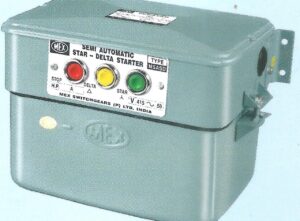MINI D.O.L. AIR BREAK CONTROL PANEL FOR THREE PHASE MOTOR & SUBMERSIBLE PUMP-MMCPTMAS
MINI D.O.L. AIR BREAK CONTROL PANEL FOR THREE PHASE MOTOR & SUBMERSIBLE PUMP-MMCPTMAS
With Automatic Motor Starter Control Switch Cum Single Phase Preventer Digital Electronic Combined V+A Meter
REWIRABLE SWITCH FUSE COMBINATION UNIT SPN / DP- MSE
REWIRABLE SWITCH FUSE COMBINATION UNIT SPN / DP MODEL – MSE
Rated Amp. Rated Volts
16 SPN 240V
16 DP 240V
32 SPN 240V
32 DP 240V
32 DP 415V
63 DP 415V
100 DP 415V
16 DP 240V
REWIRABLE SWITCH FUSE COMBINATION UNIT TP/TPN – MSE
REWIRABLE SWITCH FUSE COMBINATION UNIT TP/TPN – MSE
Code No. Rated Amp. Rated Volts
511 16 TP 415V
512 16TPN 415V
513 32 TP 415V
514 32 TPN 415V
515 63 TP 415V
516 63 TPN 415V
517 100 TP 415V
518 100 TPN 415V
519 200 TP 415V
520 200 TPN 415V
SEMI AUTOMATIC STAR-DELTA OIL IMMERSED STARTER Having Three Push Buttons with Bimetal Thermal Relay-MSASD
SEMI AUTOMATIC STAR-DELTA OIL IMMERSED STARTER Having Three Push Buttons with Bimetal Thermal Relay-MSASD
SEMI AUTOMATIC STAR-DELTA OIL IMMERSED STARTER
Having Three Push Buttons with Bimetal Thermal Relay-MSASD
SEMI AUTOMATIC STAR-DELTA OIL IMMERSED STARTER with Bimetal Thermal Relay (Heavy Duty Contacts) – SUPER MEX
SEMI AUTOMATIC STAR-DELTA
OIL IMMERSED STARTER
with Bimetal Thermal Relay (Heavy Duty Contacts) – SUPER MEX
STAR-DELTA AIR BREAK CONTOL PANEL FOR THREE PHASE SUBMERSIBLE PUMP – MCPABSD
STAR-DELTA AIR BREAK CONTOL PANEL FOR THREE PHASE
SUBMERSIBLE PUMP – MCPABSD
HAVING 2 PUSH BUTTONS With Automatic Motor Starter Control Switch Cum Single Phase Preventer
Code No. H.P
394 15&20
395 25&30
396 35&40
397 45&50
398 60
STAR-DELTA AIR BREAK CONTOL PANEL FOR THREE PHASE SUBMERSIBLE PUMP HAVING 3 PUSH BUTTONS-MCPABSD
STAR-DELTA AIR BREAK CONTOL PANEL FOR THREE PHASE SUBMERSIBLE PUMP HAVING 3 PUSH BUTTONS-MCPABSD
With Automatic Motor Starter Control Switch Cum Single Phase Preventer

 Lighting Equipment Company
Lighting Equipment Company 








